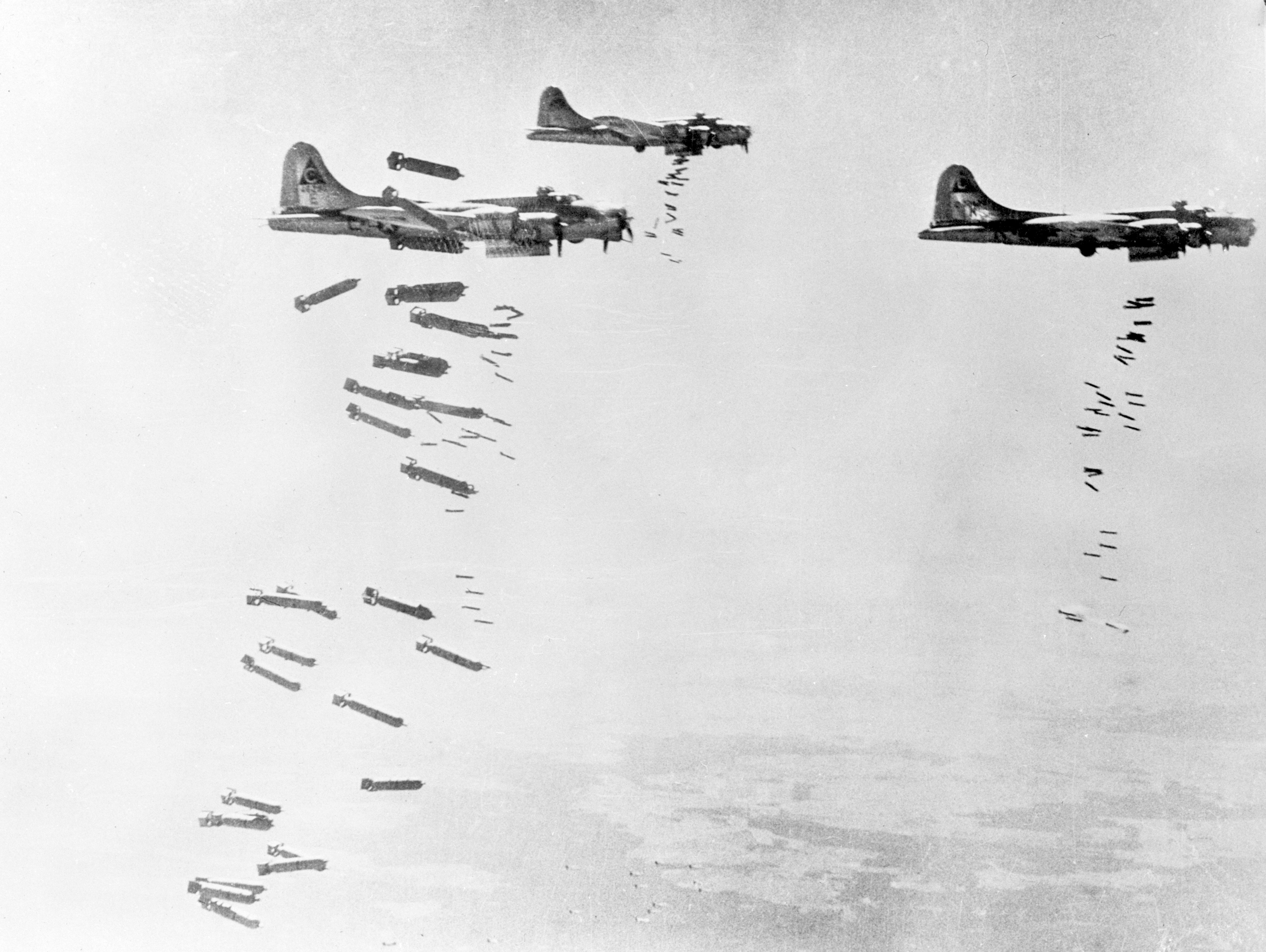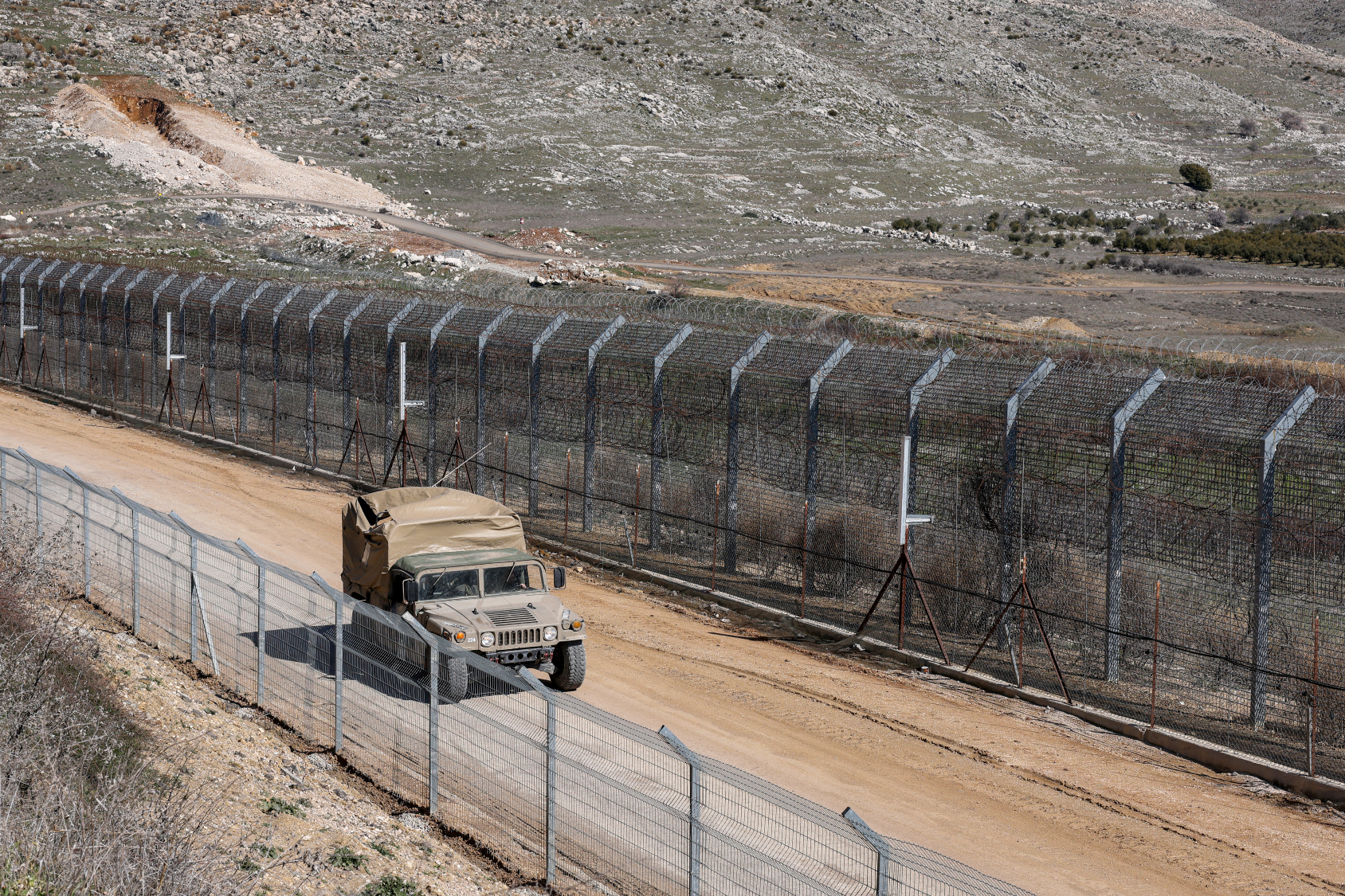American bombs are still buried under German towns. And they're blowing up.
Seventy years after World War II, thousands of undetonated U.S. bombs are still buried under German towns and cities

On March 15, 1945, the first of more than 1,300 bombers crossed the Channel coast north of Amsterdam at an altitude of almost five miles. They flew on into Germany, and around 2:40 p.m., 10 miles northwest of Berlin, the city of Oranienburg appeared beneath them. Sitting in the lead plane, the bombardier stared through his bombsight into the haze below. Five bombs tumbled into the sky.
Between 1940 and 1945, U.S. and British air forces dropped 2.7 million tons of bombs on Europe, half of them on Germany. By the time the Nazi government surrendered, in May 1945, the industrial infrastructure of the Third Reich — railheads, arms factories, and oil refineries — had been crippled, and dozens of cities across Germany had been reduced to moonscapes of cinder and ash.
Under Allied occupation, reconstruction began almost immediately. Yet as many as 10 percent of the bombs dropped by Allied aircraft had failed to explode, and as East and West Germany rose from the ruins of the Reich, thousands of tons of unexploded airborne ordnance lay beneath them. In both East and West, responsibility for defusing these bombs — and for removing the innumerable hand grenades, bullets, and mortar and artillery shells left behind — fell to police bomb-disposal technicians and firefighters, the KMBD.
Subscribe to The Week
Escape your echo chamber. Get the facts behind the news, plus analysis from multiple perspectives.

Sign up for The Week's Free Newsletters
From our morning news briefing to a weekly Good News Newsletter, get the best of The Week delivered directly to your inbox.
From our morning news briefing to a weekly Good News Newsletter, get the best of The Week delivered directly to your inbox.
Even now, 70 years later, more than 2,000 tons of unexploded munitions are uncovered on German soil every year. Before any construction project begins in Germany, the ground must be certified as cleared of unexploded ordnance. Last May, some 20,000 people were evacuated from an area of Cologne while authorities removed a 1-ton bomb that had been discovered during construction work. In November 2013, another 20,000 people in Dortmund were cleared out while experts defused a 4,000-pound "blockbuster" — a bomb that could destroy most of a city block. In 2011, 45,000 people were forced to leave their homes — the largest evacuation in Germany since World War II — when a drought revealed a similar device lying on the bed of the Rhine in the middle of Koblenz.
German bomb-disposal squads are among the busiest in the world. Eleven bomb technicians have been killed in Germany since 2000, including three in 2010 who died in a single explosion while trying to defuse a 1,000-pound bomb on the site of a popular flea market in Göttingen.
Early one winter morning, Horst Reinhardt, chief of the Brandenburg state KMBD, told me that when he started in bomb disposal in 1986, he never believed he would still be at it almost 30 years later. Yet his men discover more than 500 tons of unexploded munitions every year and defuse an aerial bomb every two weeks or so. "People simply don't know that there's still that many bombs under the ground," he said.
In one city in his district, the events of 70 years ago ensure that unexploded bombs remain a daily menace. The place looks ordinary enough: a drab main street, pastel-painted apartment houses, a McDonald's. Yet, according to Reinhardt, Oranienburg is the most dangerous city in Germany.
A free daily email with the biggest news stories of the day – and the best features from TheWeek.com
Between 2:51 and 3:36 p.m. on March 15, 1945, more than 600 aircraft of the Eighth Air Force dropped 1,500 tons of high explosives over Oranienburg, a cluster of strategic targets including rail yards, a Heinkel aircraft plant, and two factories run by the chemical conglomerate Auergesellschaft.
As one squadron of B-17s followed another, almost 5,000 500- and 1,000-pound bombs fell across the rail yards, the chemical factory, and into the residential streets nearby. These bomb loads were unlike almost any others the Air Force dropped over Germany during the war. The majority of the bombs were armed not with percussion fuses, which explode on impact, but with time-delay fuses. The sophisticated, chemical-based fuses were intended to be used sparingly; U.S. Air Force guidelines recommended fitting them in no more than 10 percent of bombs in any given attack. But for reasons that have never become clear, almost every bomb dropped during the March 15 raid on Oranienburg was armed with one.
Screwed into a bomb's tail beneath its stabilizing fins, the fuse contained a small glass capsule of corrosive acetone mounted above a stack of paper-thin celluloid disks. The disks held back a spring-loaded firing pin, cocked behind a detonator. As the bomb fell, it tilted nose-down, and a windmill in the tail stabilizer began spinning in the slipstream, turning a crank that broke the glass capsule. The bomb was designed to hit the ground nose-down, so the acetone would drip toward the disks and begin eating through them. This could take minutes or days, depending on the concentration of acetone and the number of disks. When the last disk weakened and snapped, the spring was released, the firing pin struck the priming charge, and — finally, unexpectedly — the bomb exploded.
Around 3 o'clock that afternoon, a B-17 released a 1,000-pound bomb some 20,000 feet above the rail yards. Quickly reaching terminal velocity, it fell southwest, missing the yards and the chemical plants, hurtling instead toward the canal and the two bridges connecting Oranienburg and the suburb of Lehnitz. Before the war this had been a quiet spot beside the water, leading to four villas among the trees. But now it was occupied by anti-aircraft guns and a pair of narrow, single-story wooden barracks. This was where the bomb finally found the earth — plunging into the sandy soil at more than 150 miles per hour before coming to rest deep underground, nose up.
As the shadows of the trees on Lehnitzstrasse lengthened in the low winter sun, acetone dripped slowly from the shattered glass capsule within the bomb's fuse. Taken by gravity, it trickled harmlessly downward, away from the celluloid disks it was supposed to weaken.
Less than two months later, Nazi leaders capitulated. In the months following V-E Day that May, a woman who had been bombed out of her home found her way, with her young son, out to Oranienburg. The town was a constellation of yawning craters and gutted factories, but not far from the canal, she found a small wooden barracks empty and intact. She moved in with her boyfriend and her son.
Paule Dietrich bought the house on the cul-de-sac in Oranienburg in 1993. He and the German Democratic Republic had been born on the same day, Oct. 7, 1949, and for a while the coincidence seemed auspicious. When he turned 10, he and a dozen or so other children who shared the birthday were taken to tea with President Wilhelm Pieck. At 20, he and the others were guests at the opening of the Berlin TV tower, the tallest building in all of Germany. Over the next 20 years, the republic was good to him. He drove buses and subway trains for the Berlin transit authority. He was given an apartment, and he became a taxi driver.
In nearby Oranienburg, where his mother had lived since the 1960s, Dietrich met an elderly lady who was trying to sell a small wooden house down by the canal — an old Wehrmacht barracks she'd lived in since the war. It needed a lot of work, but it was right by the water. Dietrich sold his car and mobile home to buy it and began working on it whenever he could. His girlfriend and Willi, their only son, joined him, and slowly the house came together. By 2005, it was finished — with a garage, a new bathroom, and a brick fireplace. Dietrich began living there full-time from May to December and planned to move in permanently when he retired.
Like everyone else in Oranienburg, he knew the city had been bombed during the war, but so had a lot of places in Germany. And parts of Oranienburg were evacuated so frequently that it was easy to believe there couldn't be many bombs left. Most people simply preferred not to think about it.
The state of Brandenburg, however, knew Oranienburg presented a unique problem. Between 1996 and 2007, the local government spent nearly $50 million on bomb disposal — more than any other town in Germany. In 2006, the state's ministry of the interior commissioned Wolfgang Spyra of the Brandenburg University of Technology to determine how many unexploded bombs might remain in the city. Spyra calculated that 326 bombs — 57 tons of high-explosive ordnance — remained hidden beneath the city's streets and yards.
The celluloid disks in the timing mechanisms had become brittle with age and acutely sensitive to vibration and shock, and the bombs had begun to go off spontaneously. A decayed fuse of this type was responsible for the deaths of the three KMBD technicians in Göttingen in 2010. They had dug out the bomb, but weren't touching it when it went off.
In January 2013, Dietrich read in the newspaper that the city of Oranienburg was going to start looking for bombs in his neighborhood. He had to fill out some forms, and in July, city contractors arrived. They drilled 38 holes in his yard, each more than 30 feet deep, and dropped a magnetometer into every one. A month later, they drilled more holes. They were zeroing in on something, but didn't say what.
It was nine in the morning on Oct. 7, 2013 — the day Dietrich turned 64 — when a delegation of city officials arrived at his front gate. "There's something here," the officials told him. "We need to get at it." Nobody used the word "bomb."
They marked the spot beside the house with an orange traffic cone and prepared to pump out groundwater from around it. Throughout October, the contractors had pumps running round the clock. They started digging at 7 every morning and stayed until 8 every night. They drank coffee in Dietrich's carport. "Paule," they said, "this will be no problem."
It took them another month to uncover the bomb, more than 12 feet down: 1,000 pounds, big as a man, rusted, its tail stabilizer gone. They shored up the hole with steel plates and chained the bomb so it couldn't move. Every night, Dietrich stayed in the house with his German shepherd, Rocky. They slept with their heads just a few feet from the hole.
On Nov. 19, the contractors were drinking coffee when their boss arrived. "Paule, you need to take your dog and get off the property immediately," he said.
Dietrich took his TV set and his dog and drove to his girlfriend's house. The streets around his house were sealed off. Two days later, he heard on the news that the KMBD said the bomb couldn't be defused; it would have to be detonated. He was walking with Rocky in the forest a mile away when he heard the explosion.
Two hours later, when the all-clear siren sounded, Dietrich drove over to his place with a friend and his son. He could barely speak. Where his house had once stood was a crater more than 60 feet across, filled with water and scorched debris. The wreckage of Dietrich's front porch leaned precariously at the edge of the crater. Dietrich wiped away tears. He was less than a year from retirement.
Sitting at a small table, Dietrich chain-smoked Chesterfields. He said he realized that he and his family had been lucky: Every summer, his grandchildren had played in a plastic pool near where the bomb had been lying; at night, they slept in a mobile home beside the pool. "Directly on the bomb," he said.
Dietrich had been offered scant financial compensation by the authorities — technically, the federal government was required to pay only for damage caused by German-made munitions. But he had a rendering of the new home he wanted to build on the site. It had once been the best prefabricated bungalow available in East Germany, he said, and a contractor in Falkensee had given him all the components of one, except for the roof. Even so, more than a year after the explosion, he hadn't started work on it.
Outside, he showed me why. In the grass at the bottom of an embankment was a patch of sandy ground. Men from the city had recently marked it with two painted stakes. They had told him only that it was a "double anomaly," but he knew precisely what they meant. Paule Dietrich had two more unexploded American bombs at the end of his yard.
Excerpted from an article that originally appeared in Smithsonian. Reprinted with permission.
-
 One year after mass protests, why are Kenyans taking to the streets again?
One year after mass protests, why are Kenyans taking to the streets again?today's big question More than 60 protesters died during demonstrations in 2024
-
 What happens if tensions between India and Pakistan boil over?
What happens if tensions between India and Pakistan boil over?TODAY'S BIG QUESTION As the two nuclear-armed neighbors rattle their sabers in the wake of a terrorist attack on the contested Kashmir region, experts worry that the worst might be yet to come
-
 Why Russia removed the Taliban's terrorist designation
Why Russia removed the Taliban's terrorist designationThe Explainer Russia had designated the Taliban as a terrorist group over 20 years ago
-
 Inside the Israel-Turkey geopolitical dance across Syria
Inside the Israel-Turkey geopolitical dance across SyriaTHE EXPLAINER As Syria struggles in the wake of the Assad regime's collapse, its neighbors are carefully coordinating to avoid potential military confrontations
-
 'Like a sound from hell': Serbia and sonic weapons
'Like a sound from hell': Serbia and sonic weaponsThe Explainer Half a million people sign petition alleging Serbian police used an illegal 'sound cannon' to disrupt anti-government protests
-
 The arrest of the Philippines' former president leaves the country's drug war in disarray
The arrest of the Philippines' former president leaves the country's drug war in disarrayIn the Spotlight Rodrigo Duterte was arrested by the ICC earlier this month
-
 Ukrainian election: who could replace Zelenskyy?
Ukrainian election: who could replace Zelenskyy?The Explainer Donald Trump's 'dictator' jibe raises pressure on Ukraine to the polls while the country is under martial law
-
 Why Serbian protesters set off smoke bombs in parliament
Why Serbian protesters set off smoke bombs in parliamentTHE EXPLAINER Ongoing anti-corruption protests erupted into full view this week as Serbian protesters threw the country's legislature into chaos


